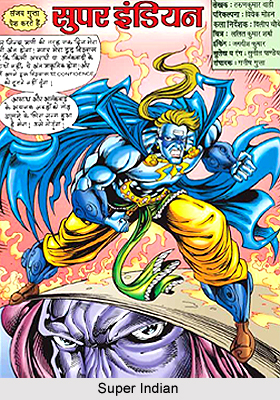 Super Indian is a superhero character in Indian comics series published and distributed by Raj Comics. The Indian superhero is created by Dilip Chaubey and Tarun Kumar Wahi. Super Indian is affiliated to the team P.O.E.M. (Protectors of Earth and Mankind) and Aman is one of his aliases.
Super Indian is a superhero character in Indian comics series published and distributed by Raj Comics. The Indian superhero is created by Dilip Chaubey and Tarun Kumar Wahi. Super Indian is affiliated to the team P.O.E.M. (Protectors of Earth and Mankind) and Aman is one of his aliases.
Concept of Super Indian
Aman, the alter ego of Super Indian, is actually a clone of fictional terrorist leader Ahankari. After a near fatal encounter with an infiltrator, named William Boother, Ahankari planned about cloning himself. Dr. Heathrow helped in the cloning process that included every aspect of Ahankari. Due to the effects of accelerated cloned genes, the cloned version grew to adulthood rapidly. A group of skilled villains was assembled to train the clone and provide him various weapons and equipments. This was done to create a perfect descendant of the terrorist leader.
In order to prevent Ahankari`s clone ending up as evil as Ahankari himself, his father requested Rudraksh Baba, an Indian mystic, to bless the clone. Initially the clone resisted but eventually he was mystically cleansed of all evil by Rudraksh Baba. The evil powers were concentrated under Trident mark, the weapon of Lord Shiva. This resulted in a seide effect that whenever the clone experienced evil, his skin became blue and he completely transformed. Rudraksh baba named the clone Aman and instructed him to live as a real hero and protect the innocent. Aman wore the traditional Indian dhoti as a sign of his embraced mysticism.
Aman renamed his hero incarnation as the Super Indian and gradually trained himself with the support from other heroes like Nagraj, Super Commando Dhruva, Doga, Bheriya etc, all part of the Raj Comics universe. Super Indian operates mostly in the fictional high-tech city called Metro City, which is his base of operations. Super Indian moves to other parts of the country as well to protect and serve the innocent. Super Indian became a part of the Protectors of Earth and Mankind, abbreviated as P.O.E.M. Aman, the secret identity of Super Indian lives with his uncles and aunt and considers them as his guardian as he has no other family members.
During his various adventures, Super Indian has encountered a range of super-villains who have created hurdles and threatened his life and Metro City. Some of his arch-nemesis are-
* Uncle Metro: The crime lord of the city, Uncle Metro knows of all the crimes that occur in the in Metro City as it happens with his permission. Super Indian, during a battle with his nephew Petro, put him into coma. Uncle Metro took oath of avenging his nephew and vowed to kill him.
* Nephew Petro: He is the nephew of Uncle Metro who is a Crime Lord. He is in coma after a brutal fight with Super Indian
* Red Eyebrow: He is a scientific genius. Red Eyebrow had the desire to be the developer of the Metro City, but some other scientist got the opportunity. Red Eyebrow now seeks revenge on the city and aims to destroy it and recreate it according to his plans.
Publications of Super Indian
Raj Comics has published several issues in the Super Indian series, like Super Indian, Super Indian Kaun, Villain Chacha, Pehla Khoon, Doosra Khoon, Project Setusamudram, Uncle Metro, Hightech Hero, TimeBomb, Ek Se Badhkar Ek, Palda, Super Villain, Live Show and Chemical Lochcha.



















